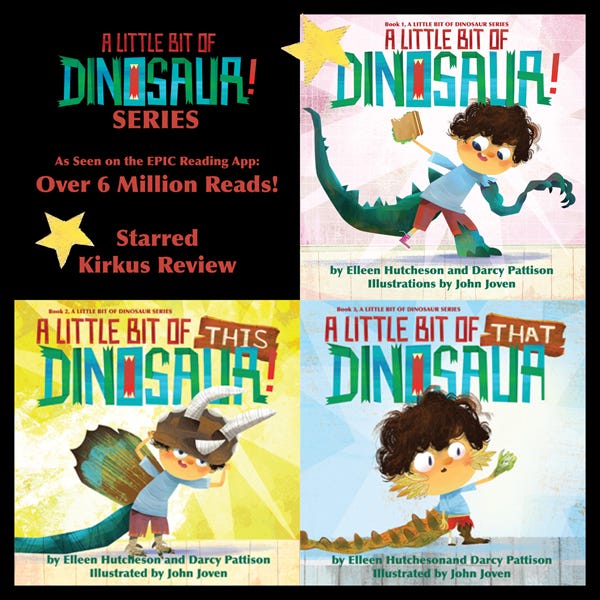Copyediting & Proofreading
Human, human, machine, machine.
I am pretty good at writing with correct spelling, grammar, punctuation, and usage. However, when I finish a story—I’m finished. I find proofreading and copyediting very, very difficult. I can’t focus on the story. Here are four ways that work for copyediting for me.
Preliminary Copyediting with Machine Learning - A.I.
I use a couple different A.I. programs for preliminary copyediting. ProWritingAid has been helpful to make sure the text reads well, but what I like most are the different ways you can analyze the text. For example, I use it to look for repeated words, when you inadvertently repeat a word because it’s top of your mind. Or for those words that become a sort of verbal tic for me. Apparently, I like the word, “bit,” as in: “I’ll be there in a little bit.” In fact, when I realized my overuse of the word, I deliberately put it into the title of a picture book, A LITTLE BIT OF DINOSAUR.
Prowriting Aid can also set custom words to look for, so it will identify the verbal tics.
Of all the A.I. programs, I’m liking Claude.ai because it’s more literary. For my new book, PUBLISH: Find Surprising Success Self-Publishing Your Children’s Book (coming in September), I set up a Claude Project and uploaded each of the 50+ chapters. Then, chapter-by-chapter, I used this prompt:
“You are a copyeditor using the Chicago Manual of Style. Copyedit the XXX chapter for spelling, grammar, punctuation, and usage. Give me back a separate file from which I can cut and paste into MSWord. Then, list the changes you made.”
This tells Claude.ai the role it will play in this task: copyeditor.
It specifies the copyediting reference: Chicago Manual of Style.
It give it four things to look at, which are generally what a human copyeditor will evaluate for: spelling, grammar, punctuation, usage.
It specifies the output: a file that can be cut-and-pasted into MSWord.
Finally, it asks for an explanation and list of changes made. That way, I can monitor changes and correct the A.I. when needed. (Yes, you can and should correct A.I.!)
Read to Me - A.I. Audio Voices
A second way that I’m proofreading is to use the Mac iOS’s built in voices to read the text to me. The standard AI voice on my computer is rather robotic, so I did upgrade (free) to a nicer premium voice. I’m highlighting a chapter, then listen and follow along on the text as it goes. This is also helping me catch repeated words (Apparently this is a pet peeve of mine, who knew?). I’m finding other places where things are unclear or slightly out of order for clarity. It’s helping me focus on what is actually on the page.
Copyeditor
Even with the machine learning options above, I hire a freelance copyeditor. Why?
I taught Freshman Composition at a local university for seven years, and the students made amusing mistakes. One that stands out is a writer who was describing a basketball game and the team’s cheerleader. He wrote, “The cheerleader was the hart of the team.”
Um. Hart/Heart. The homophones are hard for machine learning to deal with, and there are many other intricacies of language that need a human.
That’s why you need a real person with skills in copyediting. My copyeditor does the usual spelling, grammar, punctuation, and usage. But she also knows the copyediting format for bibliographies, lists of sources, or photograph credits. And, she is up-to-date on changes in the Chicago Manual of Style. Who knows if the A.I. programs are up-to-date?
My copyeditor also does fact checking on my nonfiction picture books and often finds tiny facts that need attention. It may be the spelling of an obscure location, or the date of an event. Her work gives me confidence that the books are accurate.
Without my copyeditor, my books would be a mess. For me, the A.I. options are a preliminary edit, and I will always continue to use a human copyeditor.
Beta Readers
A final way for proofreading and copyediting is to use beta readers. These are people who are passionate about your story and willing to spend the time reading it ahead of publication. They mark the tiny errors that you overlook.
But also, they are the readers for your story. It’s a good way to make sure the text meets their needs, hits the right notes for them, and educates and entertains them as you had planned. The feedback might be that you need less information here and more there. This type of feedback is a checkup to see if the author is connecting with the reader on the right levels.
In fact, I am looking for about ten beta readers for my forthcoming book, PUBLISH: Find Surprising Success Self-Publishing Your Children’s Book. The book will publish in September, so this is a great way to get an early look. It should be ready in about a week—I just need to listen to the last half of the book and make corrections. It will be in a digital format (ebook) and you’ll have about two weeks to read through it and get back to me with comments. If you can make that kind of commitment—bless you!—please leave a comment below.
By the way, if you’re a paid subscriber (thank you!), you will automatically receive an ebook copy of the book when it publishes. It’s a thank-you for hanging out here and helping me think and write about indie publishing children’s books.




I would love to be a beta reader.
I would love to be a beta reader.